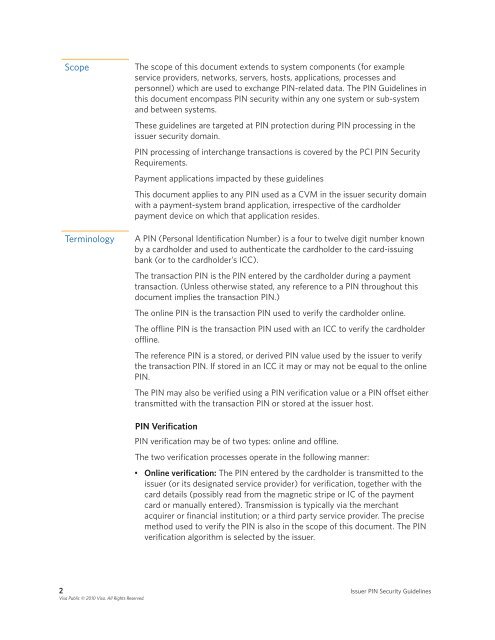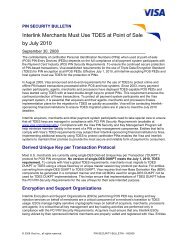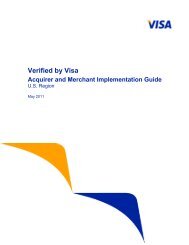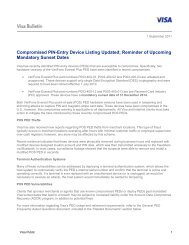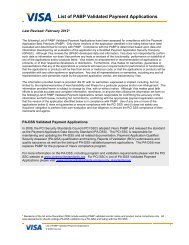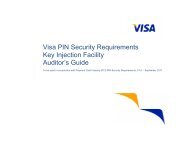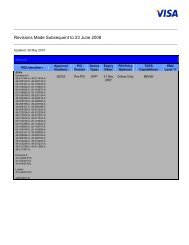Issuer PIN Security Guidelines - Visa
Issuer PIN Security Guidelines - Visa
Issuer PIN Security Guidelines - Visa
You also want an ePaper? Increase the reach of your titles
YUMPU automatically turns print PDFs into web optimized ePapers that Google loves.
Scope The scope of this document extends to system components (for example<br />
service providers, networks, servers, hosts, applications, processes and<br />
personnel) which are used to exchange <strong>PIN</strong>-related data . The <strong>PIN</strong> <strong>Guidelines</strong> in<br />
this document encompass <strong>PIN</strong> security within any one system or sub-system<br />
and between systems .<br />
These guidelines are targeted at <strong>PIN</strong> protection during <strong>PIN</strong> processing in the<br />
issuer security domain .<br />
<strong>PIN</strong> processing of interchange transactions is covered by the PCI <strong>PIN</strong> <strong>Security</strong><br />
Requirements .<br />
Payment applications impacted by these guidelines<br />
This document applies to any <strong>PIN</strong> used as a CVM in the issuer security domain<br />
with a payment-system brand application, irrespective of the cardholder<br />
payment device on which that application resides .<br />
Terminology A <strong>PIN</strong> (Personal Identification Number) is a four to twelve digit number known<br />
by a cardholder and used to authenticate the cardholder to the card-issuing<br />
bank (or to the cardholder’s ICC) .<br />
The transaction <strong>PIN</strong> is the <strong>PIN</strong> entered by the cardholder during a payment<br />
transaction . (Unless otherwise stated, any reference to a <strong>PIN</strong> throughout this<br />
document implies the transaction <strong>PIN</strong> .)<br />
The online <strong>PIN</strong> is the transaction <strong>PIN</strong> used to verify the cardholder online .<br />
The offline <strong>PIN</strong> is the transaction <strong>PIN</strong> used with an ICC to verify the cardholder<br />
offline .<br />
The reference <strong>PIN</strong> is a stored, or derived <strong>PIN</strong> value used by the issuer to verify<br />
the transaction <strong>PIN</strong> . If stored in an ICC it may or may not be equal to the online<br />
<strong>PIN</strong> .<br />
The <strong>PIN</strong> may also be verified using a <strong>PIN</strong> verification value or a <strong>PIN</strong> offset either<br />
transmitted with the transaction <strong>PIN</strong> or stored at the issuer host .<br />
<strong>PIN</strong> Verification<br />
<strong>PIN</strong> verification may be of two types: online and offline .<br />
The two verification processes operate in the following manner:<br />
• Online verification: The <strong>PIN</strong> entered by the cardholder is transmitted to the<br />
issuer (or its designated service provider) for verification, together with the<br />
card details (possibly read from the magnetic stripe or IC of the payment<br />
card or manually entered) . Transmission is typically via the merchant<br />
acquirer or financial institution; or a third party service provider . The precise<br />
method used to verify the <strong>PIN</strong> is also in the scope of this document . The <strong>PIN</strong><br />
verification algorithm is selected by the issuer .<br />
2 <strong>Issuer</strong> <strong>PIN</strong> <strong>Security</strong> <strong>Guidelines</strong><br />
<strong>Visa</strong> Public © 2010 <strong>Visa</strong>. All Rights Reserved.


